We have been curious about (and concerned by) the intersection of chemicals, indoor air quality (IAQ), and rising temperatures caused by climate change. We spend 90% of our time indoors and the materials that make up our indoor environment, and the chemicals used to make them, have a major impact on our health. But those materials don’t exist in a vacuum. Changes to our outdoor environments impact the way materials (and the chemicals within) perform indoors.
According to researchers at UC Berkeley, “There is little published literature that specifically considers the effects of climate change on indoor air quality that would influence public health.” But that is beginning to change. We want to share our initial findings as we try to answer the question:
What can we learn about the relationship between: Climate + Chemicals + Human Health?
Higher heat = lower Indoor Air Quality
Studies are beginning to show a clear link between rising global temperatures and deteriorating indoor air quality. According to a report in the International Journal of Environmental Research and Public Health, “The increase in temperature may lead to higher indoor concentrations of airborne pollutants causing higher risks of allergy, cancer, and endocrine disruption.” These are risks associated with a host of toxic chemicals commonly found in building materials and furnishings. While there are many surfaces in the interior that contain VOCs, we look at one product as an example - specifically, laminate flooring.
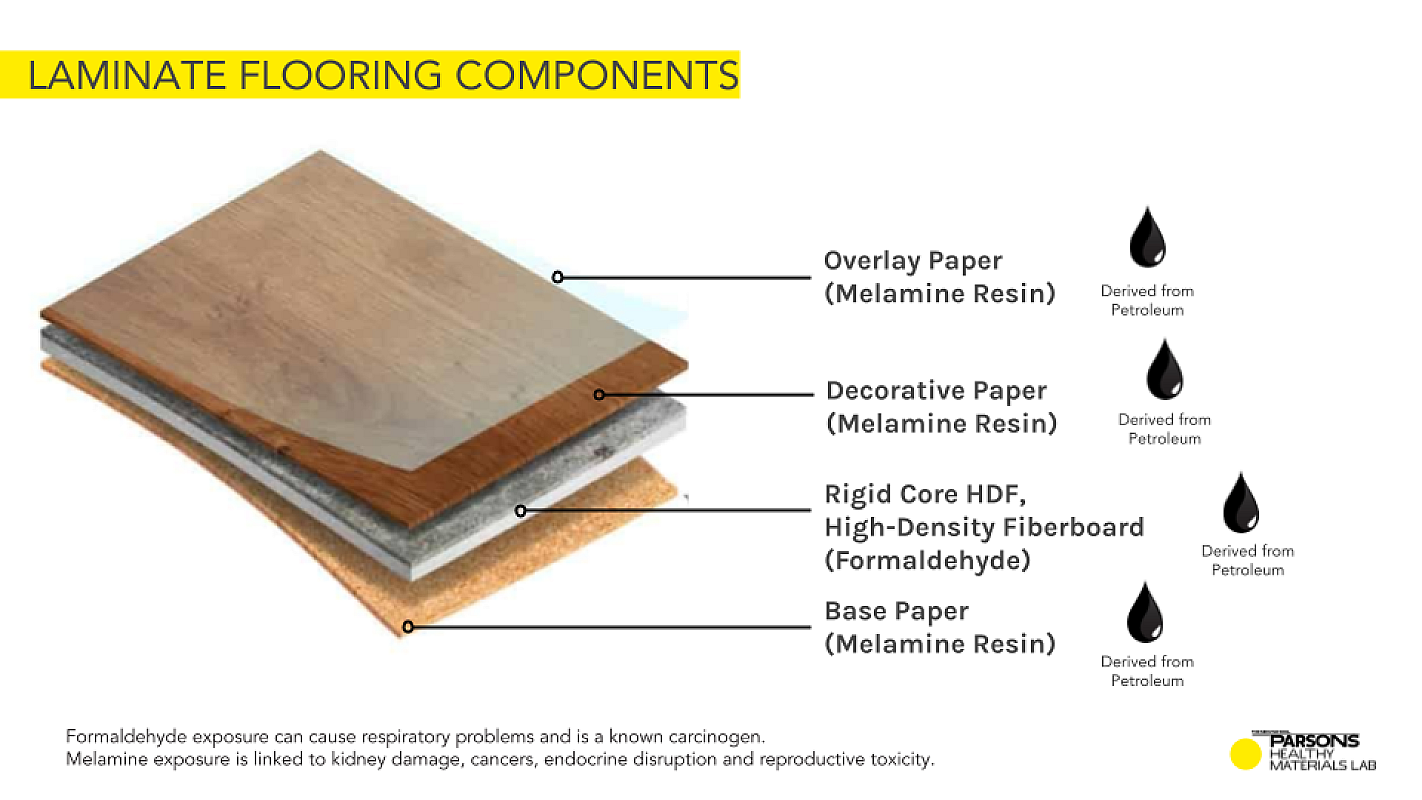
Diagram of Laminate Flooring Components
The graph below shows an increase in VOCs off gassing from laminate flooring, specifically the resins within its composition. VOCS are evaluated through two metrics; TVOC refers to Total Volatile Organic Compounds and 5VOC refers to the five specific VOCs: benzene, toluene, ethylbenzene, xylene, and styrene. As the temperature rises from 25 celsius to 45 celsius, TVOC levels increase more than 3 times.
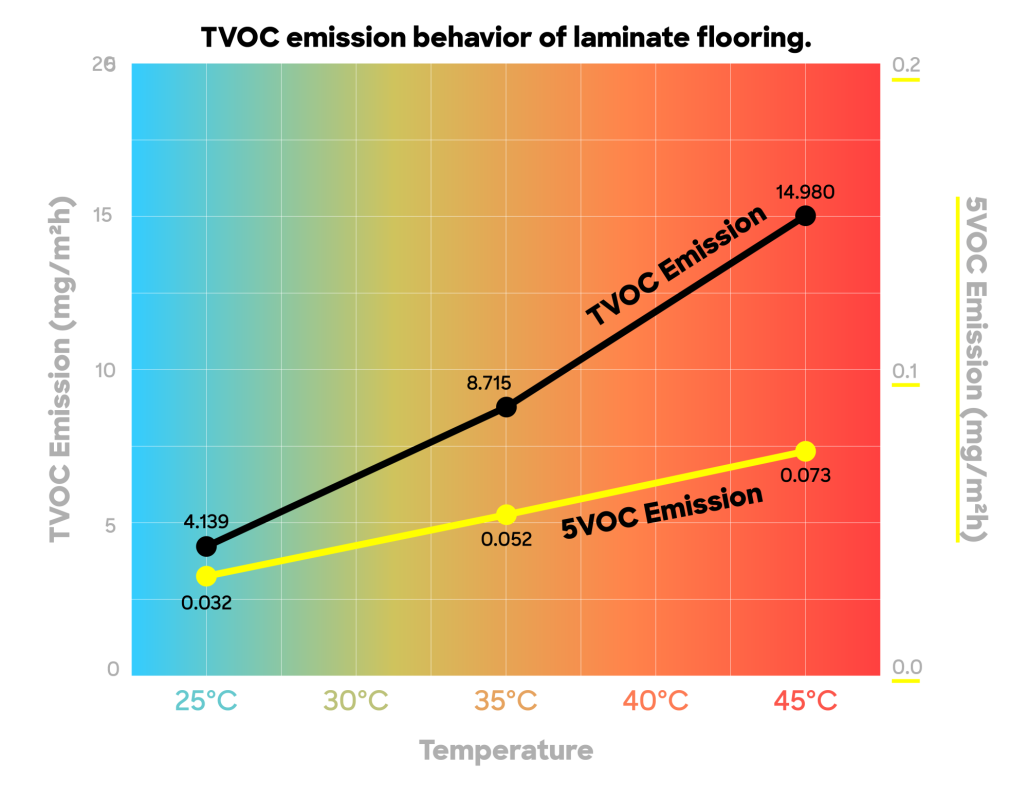
Diagram of VOC emissions from laminate flooring. TVOC refers to Total Volatile Organic Compounds or all VOCs between C6 and C16. 5VOC refers to five specific VOCs: benzene, toluene, ethylbenzene, xylene, and styrene.
Researchers found that, "The VOC emission rate can increase significantly under increased temperature, thus global warming and heat waves in summer may lead to higher indoor VOC source emissions in the years to come.”
Predicting impact
Studies addressing the impacts of specific materials can help us to identify and replace harmful materials with no or low VOC alternatives. We are also interested in models which can quantify the increased chemical exposure impacts across a whole room or building, displaying the significance of material health at a larger scale. Scientists are working on holistic models to predict indoor air quality based on future climate predictions. The Indoor Air Quality Climate Change Model looks at 5 submodels as inputs which influence the overall indoor air quality:
Building Physics: Based on a hygrothermal1 simulation model, including temperature, humidity, building envelope, and ventilation
Emissions: From materials (floor coverings, wall surfaces/coverings, plaster, furniture) and from human behavior (cooking, candles, cleaning, electronics)
Chemical-Physical Processes: VOC degradation into aerosols and particulate matter
Mold Growth: Based on mathematical models of mold potential
Human Exposure: Inhalation of particles, gasses, deposition in lungs, microorganism exposure, thermal comfort
VOCs are just one of the ways our indoor environments are compromised. We advocate for scientists to include other kinds of chemical degradation in building products, human exposure methods and pathways into future models.
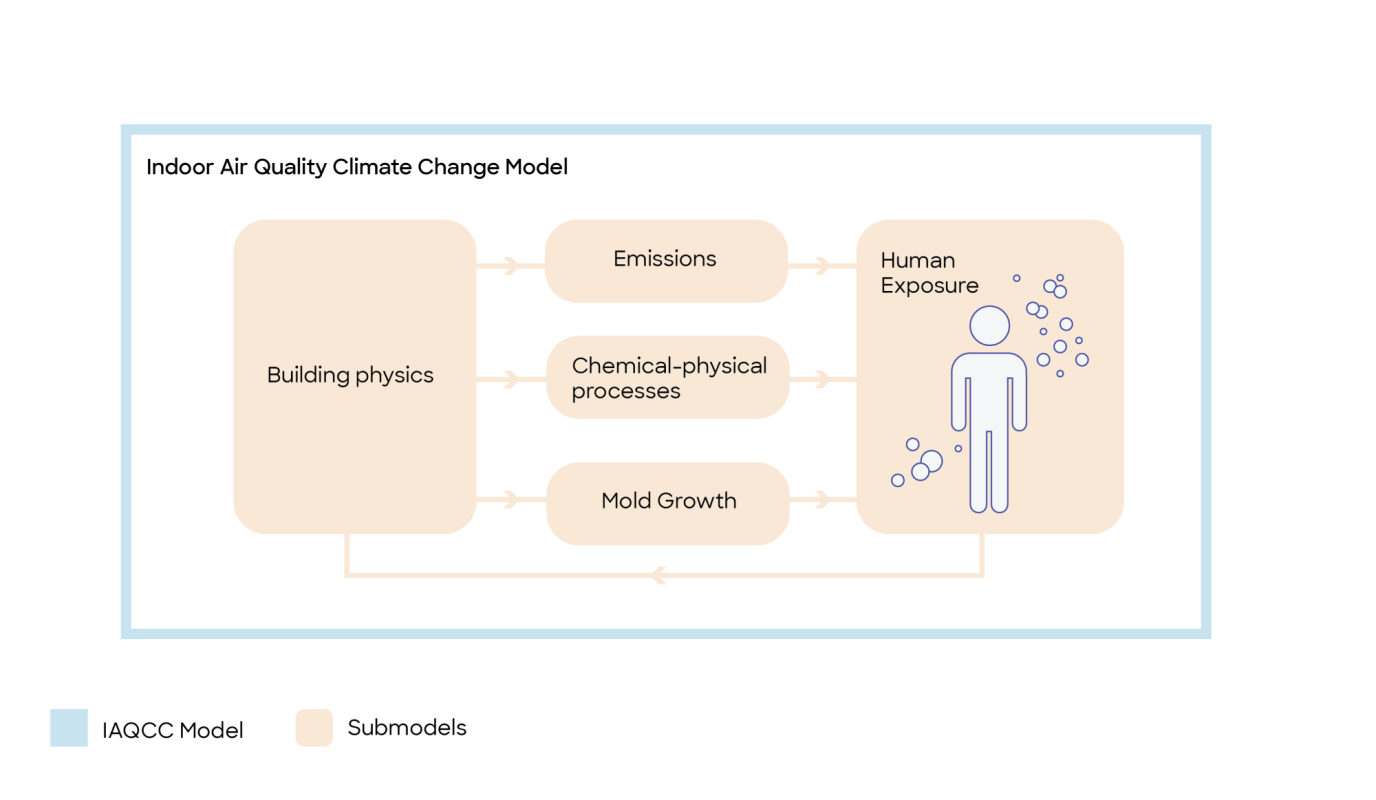
Graph of Indoor Air Quality Climate Change Model
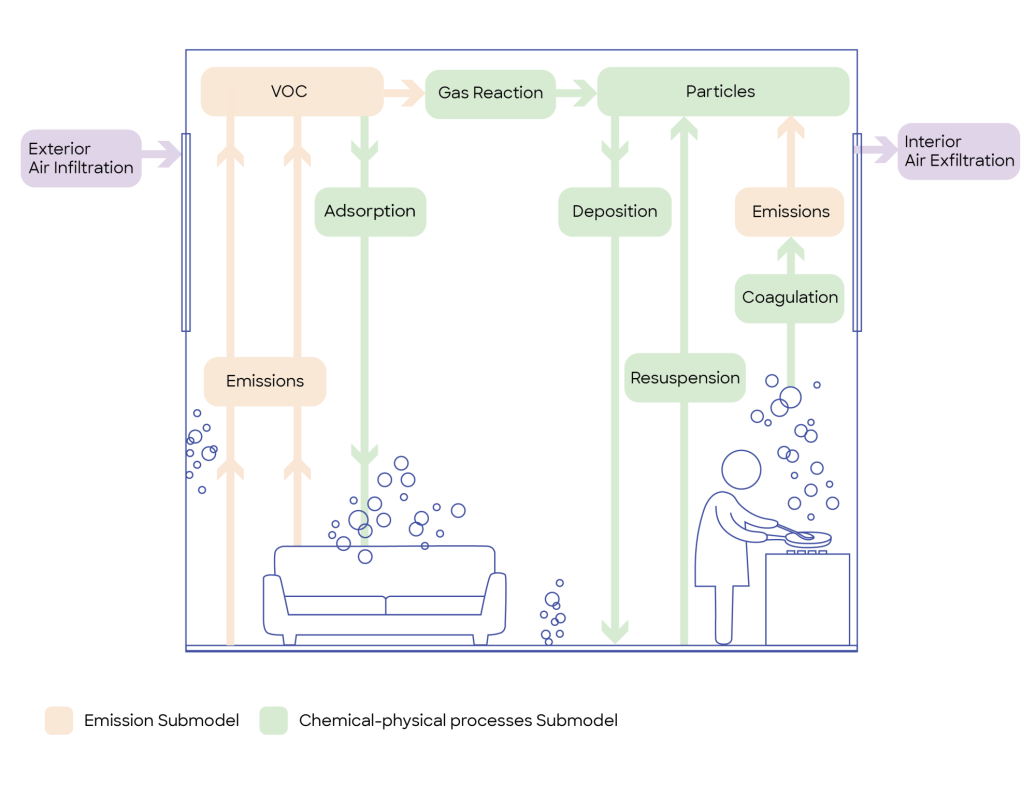
The future is now
While models like the IAQCC are hugely beneficial as we adapt the way we build for the climate of the future, the impacts of climate change are being felt right now. Importantly, they aren’t being felt equally. Globally, urban areas face higher temperatures and residents of those areas with less green space will continue to suffer disproportionately as temperatures rise. In the US, neighborhoods across the country that were redlined in the early 20th century are typically the hottest in their respective regions. According to the New York Times, “neighborhoods that are poorer and have more residents of color can be 5 to 20 degrees Fahrenheit hotter in summer than wealthier, whiter parts of the same city.”
This image below by the New York Times shows Richmond, Virginia. Past redlined3 areas are significantly warmer than other parts of the city.
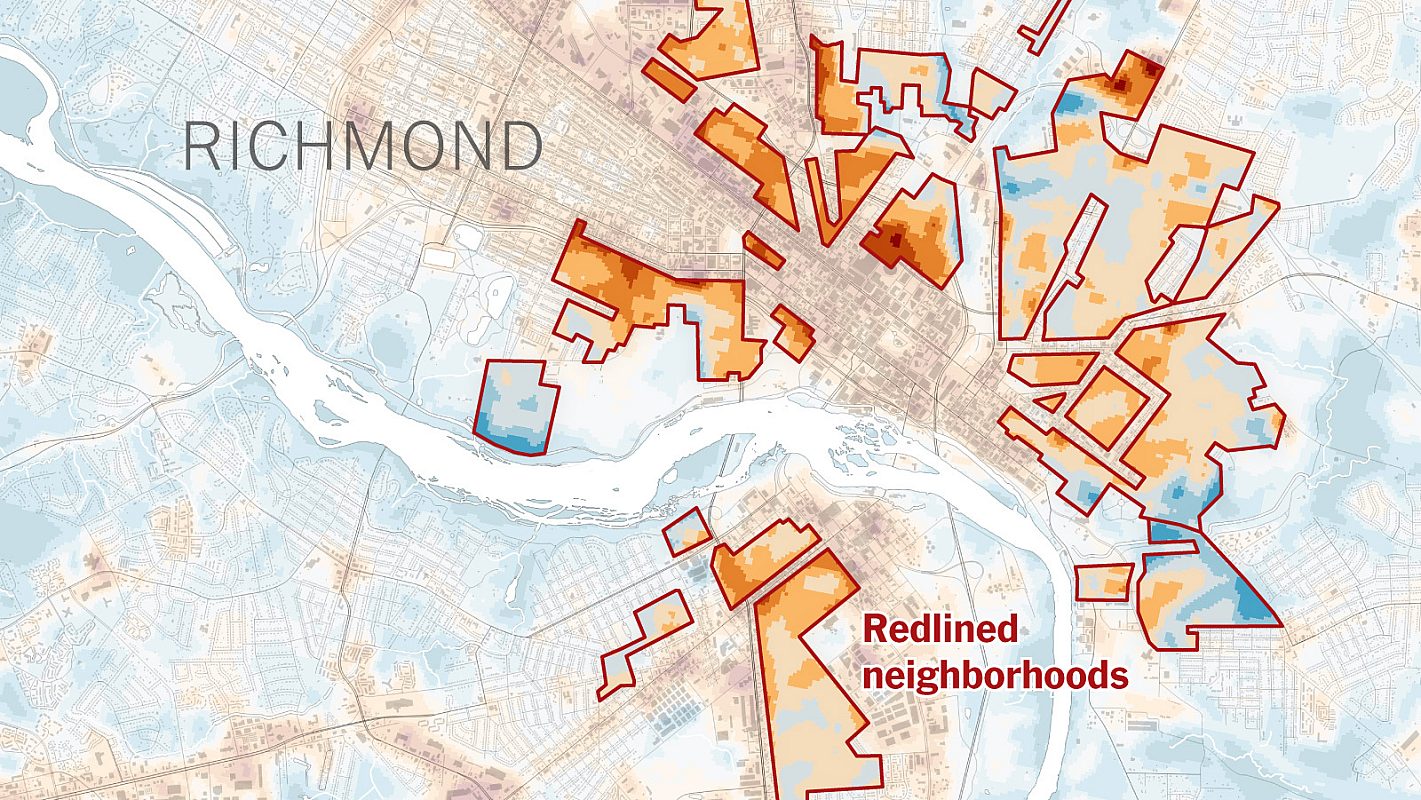
Graph by the New York Times of redlined neighborhoods in Richmond, VA, shown exemplary for many cities in the USA. On average, redlined areas are 5 degrees hotter, with some neighborhoods reaching a 15 degree increase.
Stay the course
Reducing the impacts of climate change will take a global effort and cooperation. As we consider the role that architects and designers play, one thing is certain: we must radically change the way we make and use building materials. Fortunately, the path for that change is clear. We know that there is a link between toxic chemicals and their human health impacts. We know many materials that contain these toxic chemicals and we have identified healthier material alternatives. Rising temperatures accelerate the need to stop using toxic materials. The consequences of staying with the status quo is becoming even more of a risk to human health. For the sake of our planet and its population, we must make the shift to healthy materials.
We see a clear relationship between Chemicals x Climate Change x Human Health. This intertwined relationship and identifying necessary strategies for change are key goals of Healthy Materials Lab.
As we continue to explore this research with experts in the US and Europe we will report back on what we find!
1 Hygrothermal refers to the effects of heat and moisture within buildings.
2 Adsorption refers to VOCs adhering to the surfaces of porous materials within a space.
Deposition refers to how particles move and attach to surfaces within a space once emitted from an indoor source.
Resuspension refers to previously settled particles reentering airways due to a disturbance.
In Coagulation, particles collide and stick together resulting in increased particle size.
3 Redlining refers to government-implemented discriminatory housing maps from the 1930s, which labeled areas with Black residents as undesirable and risky for investment.
Read More
Join Our Academic Network
Get Access to our carefully researched and curated academic resources, including model syllabi and webinars. An email from an academic institution or a .edu email address is required. If your academic institution does not use .edu email addresses but you would like to join the network, please contact healthymaterialslab@newschool.edu.
Already have an account? Log in